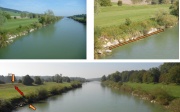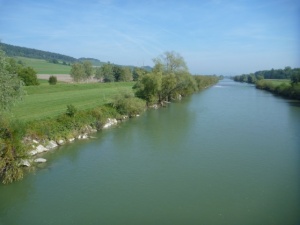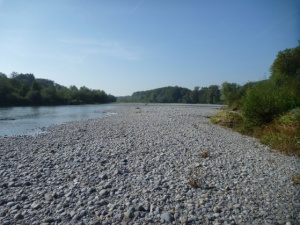Difference between revisions of "Thur"
(→Thur) |
(→Site description) |
||
| Line 18: | Line 18: | ||
Before river engineering in 1890, the river braided, gravel bars were frequent, islands were present, natural alluvial forest accompanied the river. The complexity and heterogeneity of the habitats were maintained by the natural dynamics of the river itself. Its regulation created a monotonous channel surrounded by high levees and accompanied by embankments which fixed the river. New agricultural land was gained behind the levees for crop production, and between the levees and the embankments for grazing. At the same time, villages and cities were better protected from flood events during which discharge can raise to 1130 m<sup>3</sup>/sec (in 1999), far from the mean annual flow of 47 m<sup>3</sup>/sec. The stabilisation of the river bed also permitted to extract drinking water filtrated in the sediment. These human interventions had direct consequences on the hydromorphological conditions, the ecosystem functioning, and its biodiversity. Gravel bars disappeared, secondary channels terrestrialised, characteristic riverine species became rare, floodplain related species disappeared and the complexity of the system was largely reduced (see photos below). | Before river engineering in 1890, the river braided, gravel bars were frequent, islands were present, natural alluvial forest accompanied the river. The complexity and heterogeneity of the habitats were maintained by the natural dynamics of the river itself. Its regulation created a monotonous channel surrounded by high levees and accompanied by embankments which fixed the river. New agricultural land was gained behind the levees for crop production, and between the levees and the embankments for grazing. At the same time, villages and cities were better protected from flood events during which discharge can raise to 1130 m<sup>3</sup>/sec (in 1999), far from the mean annual flow of 47 m<sup>3</sup>/sec. The stabilisation of the river bed also permitted to extract drinking water filtrated in the sediment. These human interventions had direct consequences on the hydromorphological conditions, the ecosystem functioning, and its biodiversity. Gravel bars disappeared, secondary channels terrestrialised, characteristic riverine species became rare, floodplain related species disappeared and the complexity of the system was largely reduced (see photos below). | ||
| − | + | [[File:Thur_Degraded.jpg|thumbnail|none|Degraded section with bank fixation and levees (orange arrows) and narrow floodplains(P. Reichter, A. Paillex)]] | |
| − | + | ||
==Measures selection== | ==Measures selection== | ||
Revision as of 14:16, 9 June 2015
Thur
Key features of the case study
The recent rehabilitation of the river Thur has been one of the prominent restoration programmes in Switzerland. It is a clear example of restoration management in Switzerland, providing information concerning restoration effects, and stimulating current and future studies. Today, in Switzerland a strong political willingness exists to increase the space available for rivers, with the hope to improve their protecting role against floods and their ecological state at the same time.
Site description
The Thur is a 127 km long river flowing from the Swiss Alps in the north east of Switzerland. It is a tributary of the Rhine river which also originates in the Swiss Alps and ends in the North Sea. The Thur is the largest Swiss river without natural or artificial reservoirs along its course. Its discharge is similar to unregulated alpine rivers, the water level can therefore increase rapidly during rain events or snowmelt. For agricultural purposes and protection of residential areas, the Thur river was embanked (late 19th century) and its natural floodplain was drastically reduced.
Before river engineering in 1890, the river braided, gravel bars were frequent, islands were present, natural alluvial forest accompanied the river. The complexity and heterogeneity of the habitats were maintained by the natural dynamics of the river itself. Its regulation created a monotonous channel surrounded by high levees and accompanied by embankments which fixed the river. New agricultural land was gained behind the levees for crop production, and between the levees and the embankments for grazing. At the same time, villages and cities were better protected from flood events during which discharge can raise to 1130 m3/sec (in 1999), far from the mean annual flow of 47 m3/sec. The stabilisation of the river bed also permitted to extract drinking water filtrated in the sediment. These human interventions had direct consequences on the hydromorphological conditions, the ecosystem functioning, and its biodiversity. Gravel bars disappeared, secondary channels terrestrialised, characteristic riverine species became rare, floodplain related species disappeared and the complexity of the system was largely reduced (see photos below).
Measures selection
Parts of the Thur river were restored, as for example in 2002 on a 2 km stretch close to the villages of Niederneunforn and Altikon (i.e. stretch selected as the restored site for the Reform project). The river was widened on one or both sides of the main river channel. Along the course of the river, embankments were removed to provide a larger space to the river. Additional wood structure were added to enhance the ability of the river to meander. Both are expected to increase diversity of instream habitats and corresponding biota. A higher interaction between the river and the old-disconnected floodplain is expected to happen. To date, hydromorphological and biological indicators both suggest an increase in river quality and conditions after restoration. Fish species like the Chondrostoma nasus and bird species like the Actitis hypoleucos found habitats within the new landscape [1]. Socio-economic studies will complement ecological approaches, to assess the benefits or restoration costs for local citizens. Moreover, long-term ecological studies will permit to study in details the success or failure of restoration. The Thur restoration is a clear example of restoration management in Switzerland, providing information concerning restoration effects, and stimulating current and future studies.
Socio-economic aspects
Socio-economic studies will complement ecological approaches, to assess the benefits or restoration costs for local citizens.
Contact person within the organization
Prof. Mario Schirmer, Eawag, Überlandstrasse 133, CH 8600 Dübendorf, Switzerland
Extra background information
Link to project website:
http://www.cces.ethz.ch/projects/nature/Record
http://www.rhone-thur.eawag.ch/
References
European Centre for River Restoration (ECRR). 2008. ECRR Addressing practitioners
Related Measures
- Reduce anthropogenic flow peaks
- Shorten the length of impounded reaches
- Link flood reduction with ecological restoration
- Establish environmental flows / naturalise flow regimes
- Widen water courses
- Allow/increase lateral channel migration or river mobility
- Remeander water courses
- Shallow water courses
- Initiate natural channel dynamics to promote natural regeneration
- Remove sediments
- Remove bank fixation
- Remove or modify in-channel hydraulic structures
- Recreate gravel bar and riffles
- Develop riparian forest
- Adjust land use to develop riparian vegetation
- Revegetate riparian zones
- Remove bank fixation
- Lower river banks or floodplains to enlarge inundation and flooding
- Remove hard engineering structures that impede lateral connectivity
- Set back embankments, levees or dikes
- Retain floodwater


